Title: Understanding the Dynamical State of Globular Clusters: Core-Collapsed vs Non-Core Collapsed
Authors: Sourav Chatterjee, Stefan Umbreit, John M. Fregeau, and Frederic A. Rasio
First Author’s Institution: Department of Astronomy, University of Florida, Gainesville, FL 32611
Globular Clusters (GCs) are dense, spherical stellar clusters that orbit a galaxy. They are tightly bound by gravity but do not contain a significant amount of dark matter – this leads to high stellar densities in their centers (i.e., cores). The high stellar densities and high masses of GCs make them an exciting laboratory to study strong dynamical interactions of stars such as stellar collisions, creating dynamical binaries (i.e., a star can capture another star when it flies by very closely), and mass segregation – the tendency for massive stars and binaries to sink inwards whereas low mass stars tend to move to the outer parts of the clusters, the so-called halos.
The dynamical evolution of GCs are determined by the energy generation in the core and the transport of this energy from the core to the halo. Energy generation is due to stellar evolution, stellar interactions with binaries, and gravitational contraction – the tendency for the cluster to contract once it loses pressure support from the kinetic energies of the stars within it. For example, hard binaries, which are tightly bound binaries with binding energies exceeding the mean kinetic energy per star in the cluster, can have a significant effect on the dynamical evolution (contraction and expansion) of the cluster. Elastic collisions of hard binaries with other stars can cause them to become “harder” (more tightly bound) and add kinetic energy to the interacting star. These collisions pump kinetic energy into the cluster, causing the cluster to expand or to halt contraction, this is called binary-burning. The interactions between binaries and star acts as a heating source which increases the total pressure of the cluster counteracting gravitational collapse. One simple way to think of this is that binary burning in GCs is analogous to nuclear fusion in stars. Both sources of burning act as an internal energy source to support the object against gravitational collapse.
There exists two distinct classes of GCs: core collapse and non-core collapse GCs. These two types of classes are determined observationally by their core density profile. That is, how the projected luminosity density decreases from the center of the cluster to its core edge. The core of a core-collapse GC follows a power law whereas that of a non-core collapse GC is essentially flat. Furthermore, these two classes show a bimodal distribution of the ratio of their core size to their half-light size (i.e., the distance from the center where half of the total light is enclosed and is a measure of the size of the cluster). The core radius/half-light radius ratios of core-collapse GCs peak around smaller core-halo size ratio values as compared to non-core collapse GCs.
A lot of interesting phenomena occur within GCs, and there still exists many unanswered questions. One important question is what are the progenitors of old GCs that we see orbiting the Milky Way and other galaxies? What evolutionary and dynamical effects have these clusters experienced? Why are there these two “distinct” classes of globular clusters and what properties determine these physical states? These are the questions the authors aim to answer.
With this goal in mind, the authors perform over 200 Monte Carlo numerical simulations to follow the dynamical evolution of GCs from their formation to an age of 12 Gyrs (the typical age of observed old GCs) spanning a diverse set of initial conditions such as their number of stars, fraction of primordial binaries (binaries formed during GC formation rather than due to stellar capture), cluster radius, and cluster mass.These initial conditions are observationally motivated from observations of super star clusters thought to be the precursors of GCs. Such super star clusters are which are bright, compact, massive regions of star formation characterized by sizes of a few parsecs, masses on the order of a million solar masses, and high mass surface densities. In these simulations, the authors place the GC at a distance of 8.5 kpc from the center of their host galaxy. They then compare the properties of their simulated GCs to those of observed GCs to see if these initial conditions are realistic and also to understand what dynamical effects are responsible for producing the GCs we observe today.
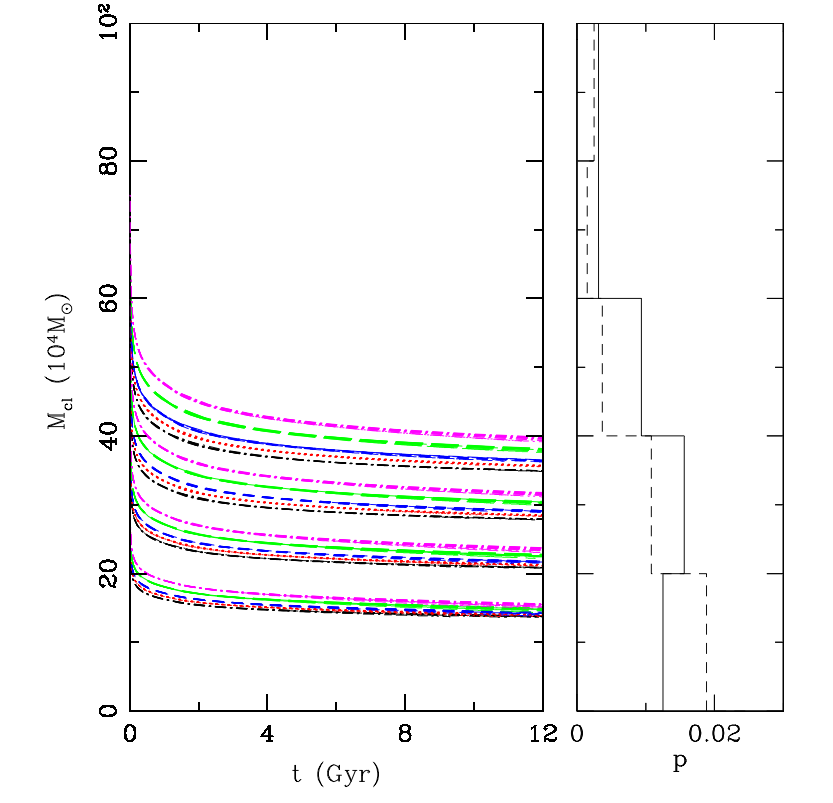
(left) Evolution of the star cluster mass for all simulated models. The black, red, blue, green, and magenta lines denote models with primordial binary fractions of 0, 0.5, 0.1, 0.2, 0.3, respectively, for each initial mass considered. (right) Solid histogram represents the masses of observed GCs which are a distance of 7-10 kpc from the center of their host galaxy. The dashed histogram is for all observed galactic GCs.
The figure above shows the mass evolution of the simulated GCs. The left panel shows the mass evolution as a function of time whereas the histogram on the right compares the final masses of the simulated clusters to the measured masses of observed GCs. As can be seen in this figure, during the first Gyr the simulated clusters lose mass very rapidly. This is due to the high mass loss via stellar winds and compact object formation for the massive stars in the clusters. After this rapid mass removal, the cluster masses decreases at a slower, nearly constant rate, caused by a steady stellar mass loss though the outer boundary of the GC. This is due to mass being tidally stripped from the GC due to it’s gravitational interaction with it’s host galaxy. The authors find that their model clusters have final masses which are comparable to the observed masses of GCs.
The next two figures show the evolution of the central density and core radius of the clusters simulated in the study. In agreement with the mass evolution figure, the authors find that the central density decreases very rapidly during the first Gyr due to mass loss from the high mass stars. This sharp decrease is followed by a nearly linear increase during the contraction phase. The core radius increases rapidly very early on which is also due to the mass loss from the massive stars that are primarily located in the center of the clusters due to mass segregation. This mechanism leads to a net loss of gravitational binding energy, which in turn causes the core of the cluster to expand. Then, when the mass loss rate significantly decreases the core contracts via two-body gravitational relaxation due to stellar interactions (i.e., exchange of kinetic energy into gravitational binding energy due to stellar interactions – click here for a mathier explanation).
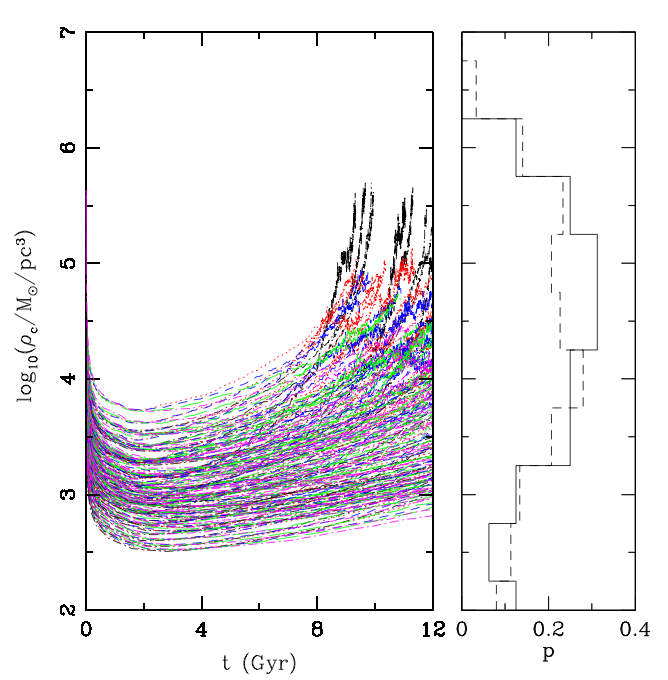
Evolution of the central density of the simulated star clusters presented in figure 1, following the same format as the previous figure. The histogram on the right shows the distribution of central density for observed GCs located 7-10 kpc from their host galaxy (solid line) and for all observed globular clusters (dashed line).

Evolution of the simulated star cluster core radius for all models presented in figure 1, following the same format as the previous figure. The histogram on the right shows the distribution of the core radii for observed GCs located 7-10 kpc from their host galaxy (solid line) and for all observed globular clusters (dashed line).
In this article, the authors used numerical simulations to follow the dynamical evolution of GCs and found that their simulations are in good agreement with observations. By using the properties of super star clusters as the initial conditions for their simulations, they further confirm that super star clusters may likely be the progenitors of GCs. Finally, the authors separate their simulated clusters into two categories: those that are undergoing binary-burning and are thus in energy equilibrium and those that are still undergoing contraction. They find that the clusters that are undergoing binary burning are in equilibrium and are likely representative of core-collapse GCs whereas those that are still contracting represent non-core collapse GCs, which in turn, provides a better understanding of the dynamical states of these evolved clusters.
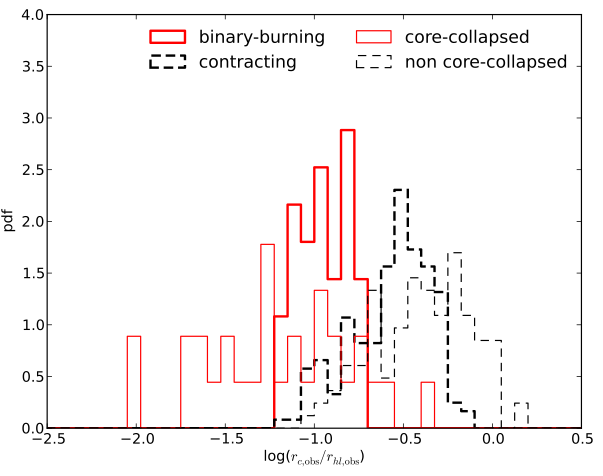
Distribution of the core-radius to half light radius ratios for observed GCs (thin lines) and simulated GCs (thick lines). The solid and dashed histrograms show distributions for model clusters in binary-burning energy equilibrium and in contraction stages, respectively. The thin solid and dashed histograms for the observed GCs show the bimodal distribution of core-collapse clusters and non core-collapse clusters, respectively.

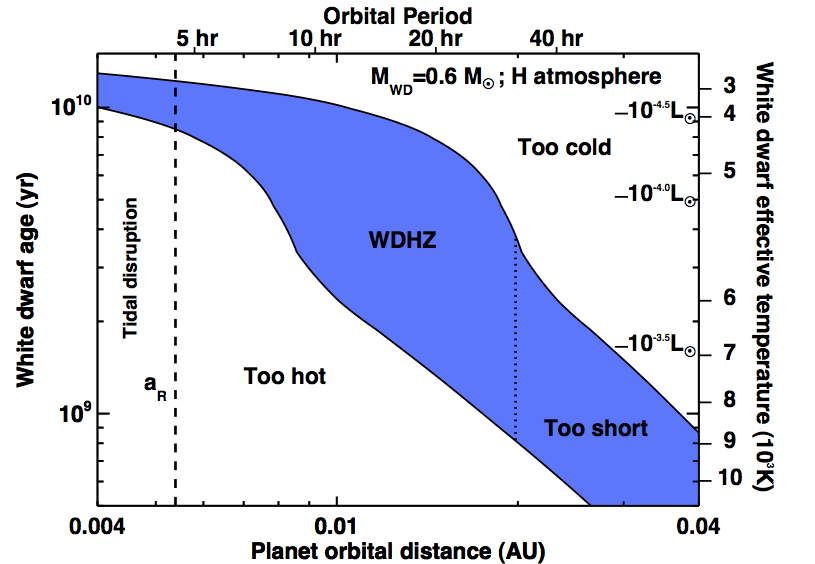


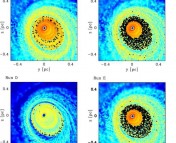
Great joy to read this article. However, I didn’t catch it, so, what’s unique/new in this paper?